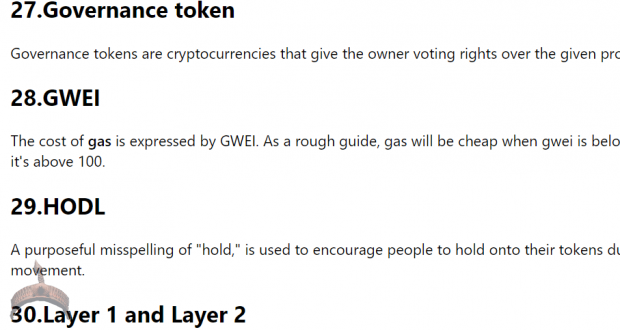41.NFT
Non-fungible token. These are digital deeds that certify ownership of a digital asset. Right now, they’re associated with art, but NFTs can certify ownership of anything digital.
42.Off-Chain/On-chain
On-chain refers to something that exists on a blockchain, off-chain refers to something that exists off the blockchain. Cryptocurrency is on-chain money, fiat currency is off-chain money.
43.OpenSea
The largest NFT marketplace, it specializes in Ethereum-based NFTs. (NFTs built on different blockchains are typically sold on dedicated marketplaces. For instance, Solana NFTs are sold on Solanart.)
44.Play to Earn (P2E)
Play to Earn (P2E) games are blockchain integrated and reward the player with an in-game cryptocurrency. These in-game cryptocurrencies can be exchanged for bitcoin or ether. The most prominent example is Axie Infinity, where players earn Smooth Love Potion ($SLP).
Axie Infinity.
Sky Mavis
45.Proof of Work
Proof of Work (POW) is a consensus mechanism through which blocks are added to a blockchain. Proof of Work requires miners to solve complicated cryptographic puzzles, which demand large amounts of energy from powerful mining rigs, in order to validate new blockchain transactions.
Proof of Work is a safe and decentralized consensus mechanism, but it’s notoriously inefficient. It’s how Bitcoin and Ethereum’s blockchains operate, although Ethereum will soon shift to the more efficient Proof of Stake.
46.Proof of Stake
Confronted with the huge energy demands of Proof of Work, Proof of Stake (POS) is an updated consensus mechanism that allows blocks to be mined much more efficiently. Proof of Stake allows holders of a cryptocurrency to validate new blocks onto the relevant blockchain.
They do this by staking their cryptocurrency. Users of a network stake their cryptocurrency, and if their stake is chosen by a randomized algorithm, they get the opportunity to validate a new block — for which they’ll get a reward in the form of more cryptocurrency. The more cryptocurrency staked, the higher chance a user is to be chosen to validate a new block.
Where Proof of Work rewards those who have spent the most computational power to solve a cryptographic puzzle, Proof of Stake rewards those who invest their cryptocurrency over a long period of time.
47.Pump and dump
Pump and dump schemes involve the building up of artificial excitement over a product, which leads people to buy it and raise its price. Pump and dump orchestrators then sell their assets at a high, which then causes the price to fall precipitously.
These exist in traditional markets but are more common in cryptocurrency trading as the low liquidity of microcap cryptocurrencies makes their prices easier to manipulate.
48.Rug pull
Rug pulls are when the creator of a cryptocurrency vanishes, taking funds with them. A phony Squid Game coin is a recent example, although these are far from rare. “Rug” is essentially shorthand for “scam.”
49.Satoshi Nakamoto
The pseudonymous creator of Bitcoin. The whitepaper explaining the need for decentralized finance and explaining how Bitcoin works were signed by a Satoshi Nakamoto, but no one knows who the real person is. It’s been speculated that Satoshi Nakamoto is actually several people.
50.Scamcoin
A cryptocurrency that has been rugged.
 Ọmọ Oòduà Naija Gist | News From Nigeria | Entertainment gist Nigeria|Networking|News.. Visit for Nigeria breaking news , Nigerian Movies , Naija music , Jobs In Nigeria , Naija News , Nollywood, Gist and more
Ọmọ Oòduà Naija Gist | News From Nigeria | Entertainment gist Nigeria|Networking|News.. Visit for Nigeria breaking news , Nigerian Movies , Naija music , Jobs In Nigeria , Naija News , Nollywood, Gist and more









